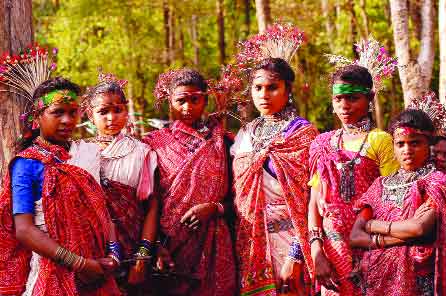Tribal development (especially adiwasis) has been a hot topic of discussion for ruling Governments as well as political parties. Ever since independence, several Governments have launched numerous programmes, which have seen minimal success in terms of enhancing the socio-economic condition of the tribal population. Of course, a miniscule group of educated people have benefitted from the policy of job reservation. But it is the land tenure reforms that have been at the forefront of tribal struggles. Many NGOs as well as social workers have been raising the issue of tribal land with the forest department. Tribal livelihood rights, after all, are intricately linked with the management of forest ecosystems. For, it is equally important that forest bio-diversity remains in good shape to meet tribal needs.
Not only the tribal people but villagers living in about 170,000 villages, situated in and around 32 million hectare of forest lands, are partially dependent on the adjoining forest lands for daily needs. As per the 2011 Census, the tribal population in India stood at 10.4 crore and constituted around 8.6 per cent of the total population. In 2004, the then NDA Government had brought to fore the issue of historical injustice regarding settlement of disputed claims of tribals over forestlands, which were pending since decades, particularly after the enactment of the Forest Conservation Act, 1980. A notification was issued on February 4, 2004, recognising the rights of occupation of forest lands by tribal people and a procedure was communicated to the States to vest the occupied land. This recognition was welcomed but could not be implemented because the NDA could not come back to power. Taking cue from this notification, the then UPA Government re-initiated the process and enacted the Scheduled Tribes and Other Traditional Forest Dwellers (Recognition of Forest Rights) Act, (FRA) 2006. Ever since, it remains one of the biggest reforms to correct the historic injustice done to tribals. It will be appropriate to examine the impact of this Act on the political economy of the tribals.
One of the biggest constraints for forest management and tribal development is that our forests, regions of tribal habitation and mineral-bearing areas overlap each other. Due to this, inherent conflicts occur. For long-term sustainability of forest management and to meet the climate change targets, it is essential that not only does our forest land become productive enough but also that the land vested under the Act can offer a decent livelihood to tribals, in a manner that their dependency on forests is gradually reduced. The ultimate goal should be that our forests are manned for ecological sustainability of all kinds of landscapes. For this to happen, it is essential that political parties assess the economic polity of the tribal-forests interface and chalk out an integrated strategy.
Let us first examine the implementation of the FRA. Though the basic surmise of the Act, before its enactment, was on community rights, it is now focussed on settling individual rights. It will be interesting to note that during the last 10 years, till May 2018, 58.5 lakh hectares of land were vested but more than half of this figure was distributed in the next five months, by the end of October 2018. The Act is open-ended and for the past 10 years, the process is still on.
This reflects that either the system is incompetent or the Act is being used as a tool to barter away forest land. The moot point is: Was it an easy task for the tribal, revenue and forests departments to ascertain the land under occupation, as on 2006 when this Act came into effect? Why it is taking so long for officials to ascertain tribal occupation? Land is a precious resource. A lackadaisical attitude in implementation will yield to increasing encroachments of our forest lands. Political parties as well as the Government must act timely, pull up their socks to fix this malady. After this, focus must be shifted to developing these lands for better returns to the beneficiaries. Land rights, however, are not the only reason for tribal alienation. The lack of infrastructure, deteriorating health conditions, struggle for livelihood and educational deprivation, too, are some of the reasons why they feel disenchanted. Unless the land vested is demarcated, digitised on priority and becomes productive, the real purpose of tribal empowerment will not be achieved.
The implementation of FRA should, therefore, be linked with the creation of livelihood. A nationally coordinated project, in collaboration with the Ministry of Environment, Forest and Climate Change, Ministry of Agriculture & Farmers’ Welfare, Ministry of Tribal Affairs, Ministry of Water Resources, River Development & Ganga Rejuvenation, Ministry of Micro, Small and Medium Enterprises, Ministry of New and Renewable Energy, Ministry of AYUSH and Ministry of Rural Development for livelihood generation is a sine qua non. The project should also have a second component, based on a cluster approach to be implemented by the Ministry of Human Resource Development, Ministry of Housing and Urban Affairs, Ministry of Health and Family Welfare, Ministry of Power to create necessary infrastructure.
Questions now arise about its implementation. Considering the interface between forests and tribes, the National Commission for Scheduled Tribes requested the Government to rename Indian Forest Service (IFS) as the Indian Forest and Tribal Service. This is an excellent proposal but renaming IFS is not essential. What is needed is to encompass tribal welfare as a core value of forest management. For this, IFS training will require changes and the Indian Institute of Forest Management and Indira Gandhi National Forest Academy should be assigned this task. The IFS cadre will require revamping to create a capable force. To begin with, one Additional Director-General’s post should be created in the Ministry of Environment to deal with tribal affairs, ensure convergence and plan future set-ups. In the long-run, a tribal child should grow up imbibing his culture while encompassing the fruits of modern development.
(The writer is a retired civil servant)
Writer: VK Bahuguna
Courtesy: The Pioneer








 OpinionExpress.In
OpinionExpress.In















Comments (0)